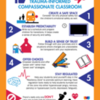The summer break is upon us and right now parents and teachers are taking a much-deserved deep breath before jumping into the new school year. One of the programs Echo provides each summer is the salary point Trauma-Informed Compassionate Classrooms training to help educators meet their professional development requirements and to give them the space to think about the classroom environment they would optimally like to create while not yet inundated with the day-to- day demands of the school year.
We were inspired by reading this article to create a short list of ‘Do’s and Don’ts of the Trauma-Informed, Compassionate Classroom’. We agree, that there is really only one ‘don’t’ and that is let’s not punish kids for behaviors that are trauma symptoms.
Here are a few ‘do’s’ to consider:
1) Create a safe space for all children to learn. What does that mean? Most school personnel don’t need much coaching about how to ensure physical safety but what about emotional safety?
2) Predictability: When children have been traumatized, they are on high alert, always expecting the next blow. Maybe they live with an unpredictable parent who buys them toys and hugs them one minute, and descends into an alcohol-fueled rage the next. Writing up the day’s schedule on the board and preparing students for transitions (“We’re going to be clearing up in 5 minutes and then we are going to go to the sports field”) helps create predictability and thus a sense of safety.
3) Trustworthiness: You promised the class they would get free time after they completed an exercise, but then someone asked a question and you took the time to explain something that you realized you should have covered in the lesson. These understandable changes of plan might seem like small beans to us, but to a child who has been around adults who constantly break their promises it can confirm what is already a deep-seated suspicion – that adults are untrustworthy. If we can provide stability and trustworthiness it will allow a child to begin to change their perceptions about how safe the world is.
4) Control: Do you get upset when your carefully laid plans are upset or when a child wants to go in a direction you had not prepared for? Many of us who experienced high levels of control growing up felt disempowered, and as a result we have an understandable urge to remain in control all the time! This is magnified for a trauma survivor whose physical or emotional safety was compromised because they had no power to protect themself at the time of the trauma. How can we begin to empower our students and offer ‘power with’ rather than ‘power over’ strategies so that we don’t reinforce these harmful power dynamics?
5) Regulation: In many cases the behaviors that cause problems in classrooms (or at home) are a child’s best attempt to communicate something to you, the adult. How much they hurt, how confused they are, how scared, how overwhelmed. Or even how exuberant and full of energy they feel when our schedule is demanding that they sit quiet and concentrate. Sometimes children need calming down, sometimes they need energizing, and by paying attention to this we can keep the whole class in what is called “The Resiliency Zone” – the place where our higher brain is online and we can access learning and memory. Children who have experienced toxic stress or trauma are easily bumped out of this zone. As a teacher, it is good to have tools for keeping kids in the Resiliency Zone as well as methods to help kids deal with the big behaviors that come with getting stuck on hyperarousal (anger, fear, anxiety) or hypoarousal (checked out, numb).
This is an abbreviated list, but if you would like to learn more about Trauma- Informed, Compassionate Classrooms and the practical tools for creating safe, stable, nurturing environments for kids, please sign up for our 2-day training. And speaking of tools, if you need help remembering these important DOs and DON’Ts check out the great, visual guide available for download on our Resource Page.


Comments (0)